selected works
Permanent Interactive Light Installation
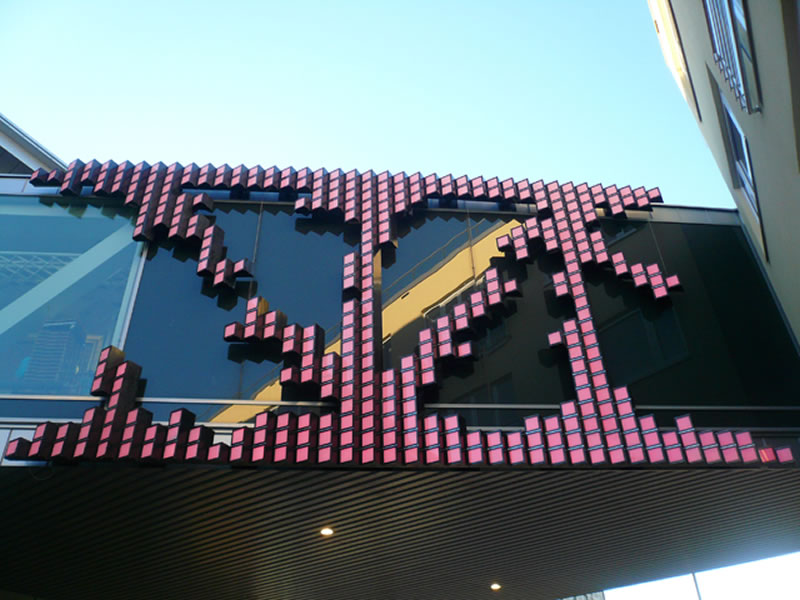
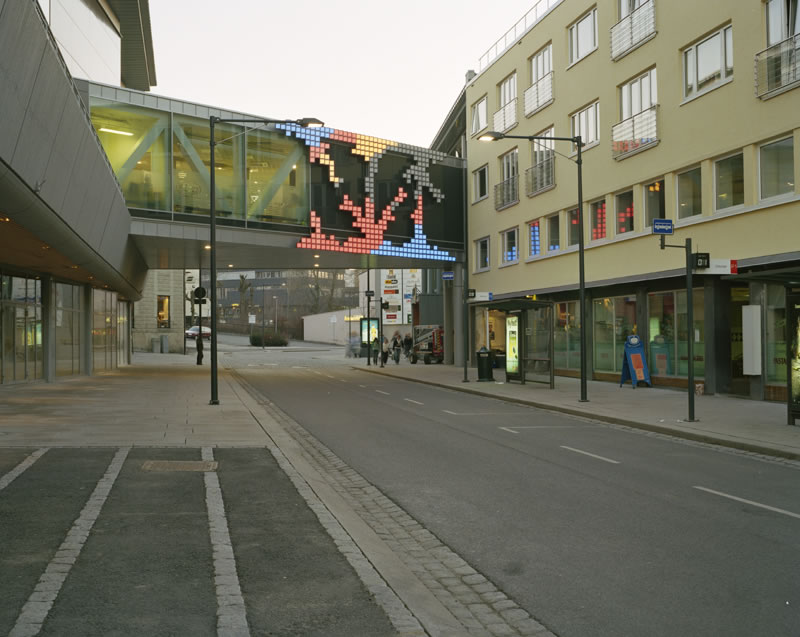
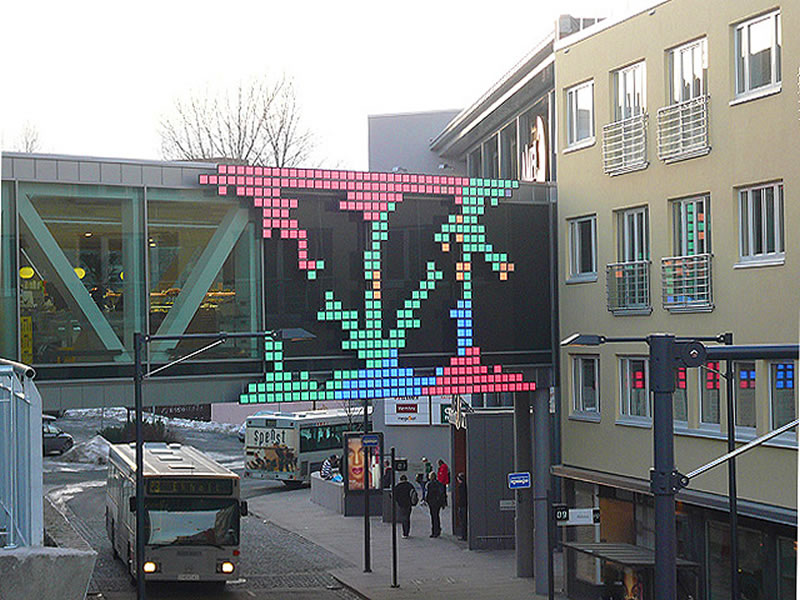
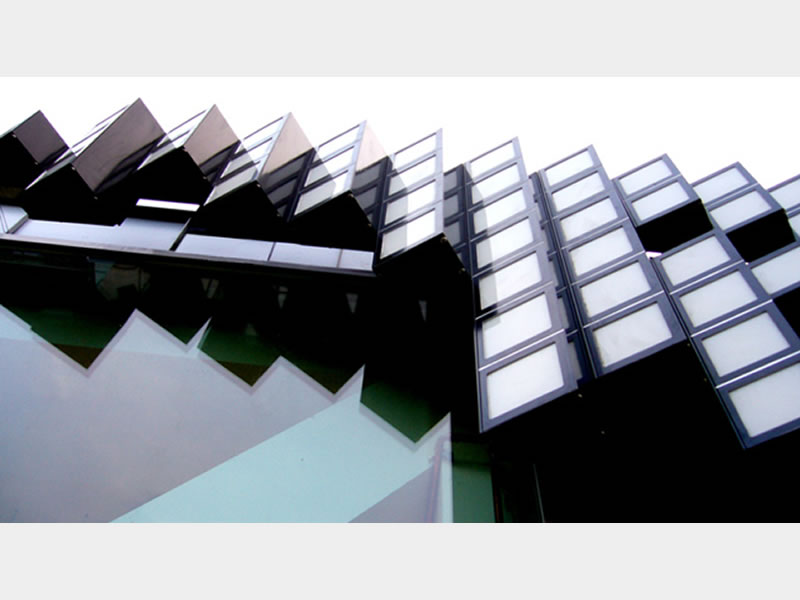
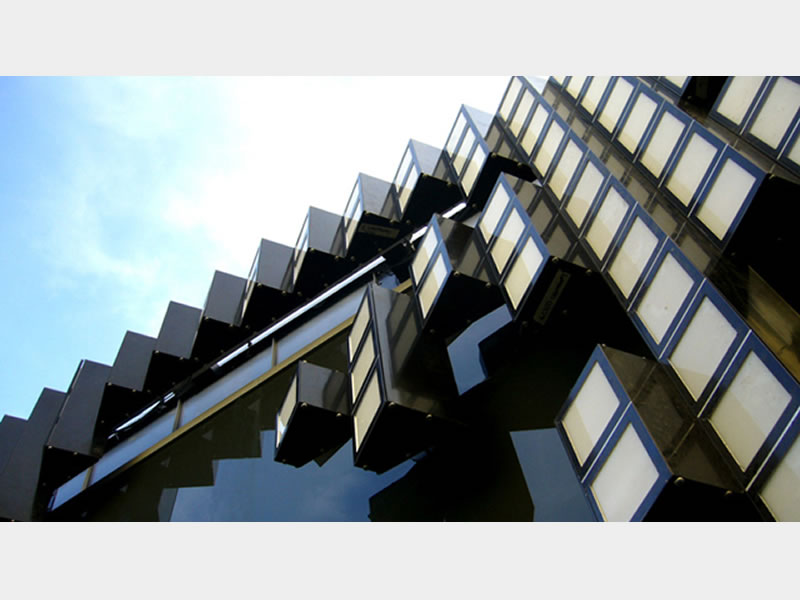
As a permanent interactive installation, a fractured mosaic of light and color aesthetisizes the open-air waiting area of the city of Moss's (NO) main bus terminal, enlivening the space while offering suggestive information about the proximity of busses through dynamically changing light and color.
Norment’s work with interactivity and architectonic structures enters the public sector with the commission of a permanent interactive art work for the city of Moss, Norway. In this work, Norment examines the metaphorical senses of an architectural site as a body in itself, extending her investigation of the sensational and psychological negotiation of bodies in environments.
Extruding from the dark glass surface of a pedestrian overpass is a fractured mosaic of 350 RGB light tiles whose dynamically changing colors and patterns are determined by the movement of the city busses that pass underneath. Busses' locations along their route are tracked utilizing GPS technology. The locations are abstractly mapped onto the design such that the patterns change with the nearing time of departure of the approaching busses. Enlivening the open-air waiting area of Moss’s (NO) main bus terminal, the effect of this permanent interactive
artwork is both aesthetic and informative.
Reactive Life
The tile structure was inspired in part by the growth of plants, such as ivy, on architecture and their reactive qualities. Many of these growths respond to their environment by changing colors with the seasons, or growing only on the North side, for example, and as such they offer us readable indications of our immediate environment. In this case, the 'growth' has chosen the shadowed corner of North side of the overpass and responds to its environment by changing colors in anticipation of the approaching busses and furthermore signaling their departure. It is a body enlivened by the activity in its environment. This reactive artwork offers an impression of time with a similar directness and abstraction as the color change in a leaf offers an impression of the season. It is a body or digital skin enlivened by the activity in its environment.
Visualization
The structure is more or less divided in half with some intertwined tiles in the center. The top portion represents (N)Eastbound busses, the bottom represents (S)Westbound busses. Accordingly for example, one can follow an Eastbound bus starting at 20 minutes away, from the tiles in the upper left corner as they progressively change colors heading towards the right and center endpoints of the structure. As other busses approach, they leave their own color trails on top of existing trails. Busses that have arrived at the station and are ready for departure are indicated by periodic flashing. With this visualization pattern, the quantity of tiles represents the time distance between busses; the more tiles of one color, the greater the time distance before the next approaching bus as indicated by the next color.
New visualization patterns will appear periodically.
The commission of the installation was a collaboration between Bjørnssonkvartalet/AMI, Moss Kommune and The Norwegian Fund for Public Art.
This project was realized was realized with the help of a talented support team:
Artistic consultant - Knut Åsdam.
Industrial design and installation coordination - Frost Produkt, Oslo.
Lighting technology - Brother, Brother and Sons, Copenhagen.
Mounting - Herstad Skiltmontage.
VIDEO FILES





As a permanent interactive installation, a fractured mosaic of light and color aesthetisizes the open-air waiting area of the city of Moss's (NO) main bus terminal, enlivening the space while offering suggestive information about the proximity of busses through dynamically changing light and color.
Norment’s work with interactivity and architectonic structures enters the public sector with the commission of a permanent interactive art work for the city of Moss, Norway. In this work, Norment examines the metaphorical senses of an architectural site as a body in itself, extending her investigation of the sensational and psychological negotiation of bodies in environments.
Extruding from the dark glass surface of a pedestrian overpass is a fractured mosaic of 350 RGB light tiles whose dynamically changing colors and patterns are determined by the movement of the city busses that pass underneath. Busses' locations along their route are tracked utilizing GPS technology. The locations are abstractly mapped onto the design such that the patterns change with the nearing time of departure of the approaching busses. Enlivening the open-air waiting area of Moss’s (NO) main bus terminal, the effect of this permanent interactive
artwork is both aesthetic and informative.
Reactive Life
The tile structure was inspired in part by the growth of plants, such as ivy, on architecture and their reactive qualities. Many of these growths respond to their environment by changing colors with the seasons, or growing only on the North side, for example, and as such they offer us readable indications of our immediate environment. In this case, the 'growth' has chosen the shadowed corner of North side of the overpass and responds to its environment by changing colors in anticipation of the approaching busses and furthermore signaling their departure. It is a body enlivened by the activity in its environment. This reactive artwork offers an impression of time with a similar directness and abstraction as the color change in a leaf offers an impression of the season. It is a body or digital skin enlivened by the activity in its environment.
Visualization
The structure is more or less divided in half with some intertwined tiles in the center. The top portion represents (N)Eastbound busses, the bottom represents (S)Westbound busses. Accordingly for example, one can follow an Eastbound bus starting at 20 minutes away, from the tiles in the upper left corner as they progressively change colors heading towards the right and center endpoints of the structure. As other busses approach, they leave their own color trails on top of existing trails. Busses that have arrived at the station and are ready for departure are indicated by periodic flashing. With this visualization pattern, the quantity of tiles represents the time distance between busses; the more tiles of one color, the greater the time distance before the next approaching bus as indicated by the next color.
New visualization patterns will appear periodically.
The commission of the installation was a collaboration between Bjørnssonkvartalet/AMI, Moss Kommune and The Norwegian Fund for Public Art.
This project was realized was realized with the help of a talented support team:
Artistic consultant - Knut Åsdam.
Industrial design and installation coordination - Frost Produkt, Oslo.
Lighting technology - Brother, Brother and Sons, Copenhagen.
Mounting - Herstad Skiltmontage.
